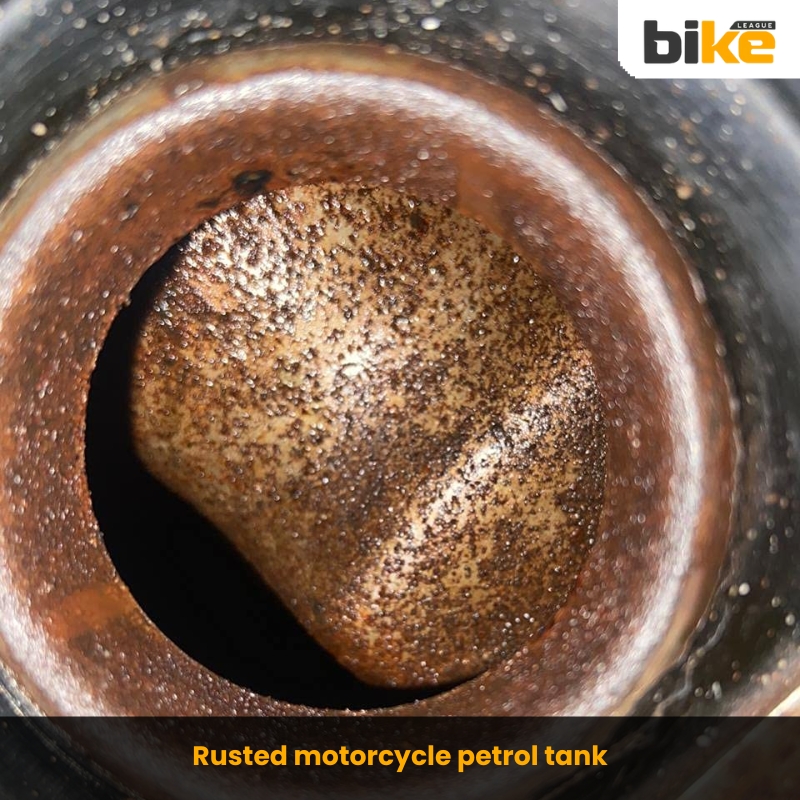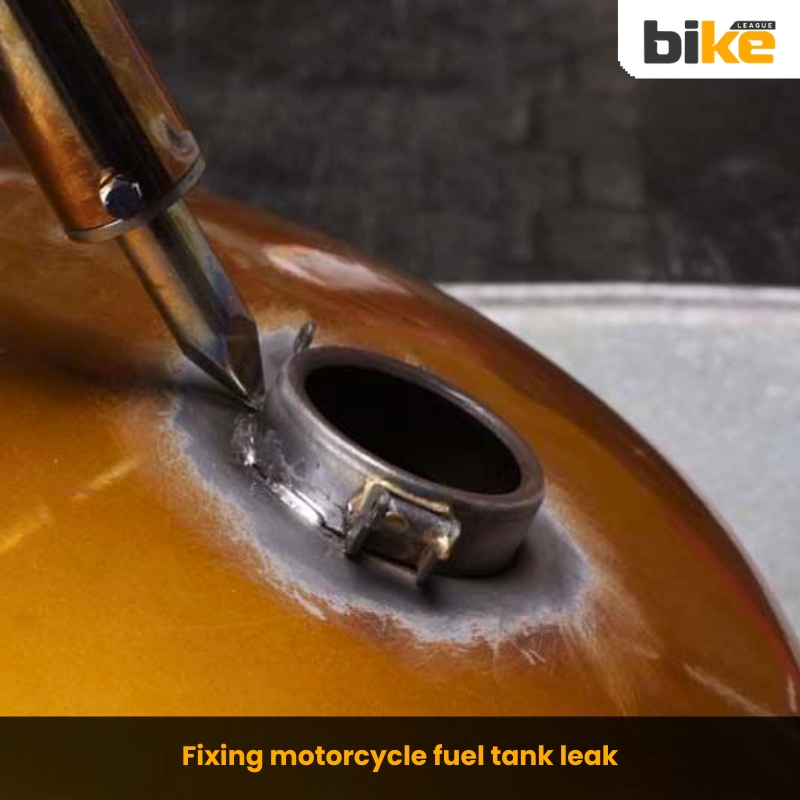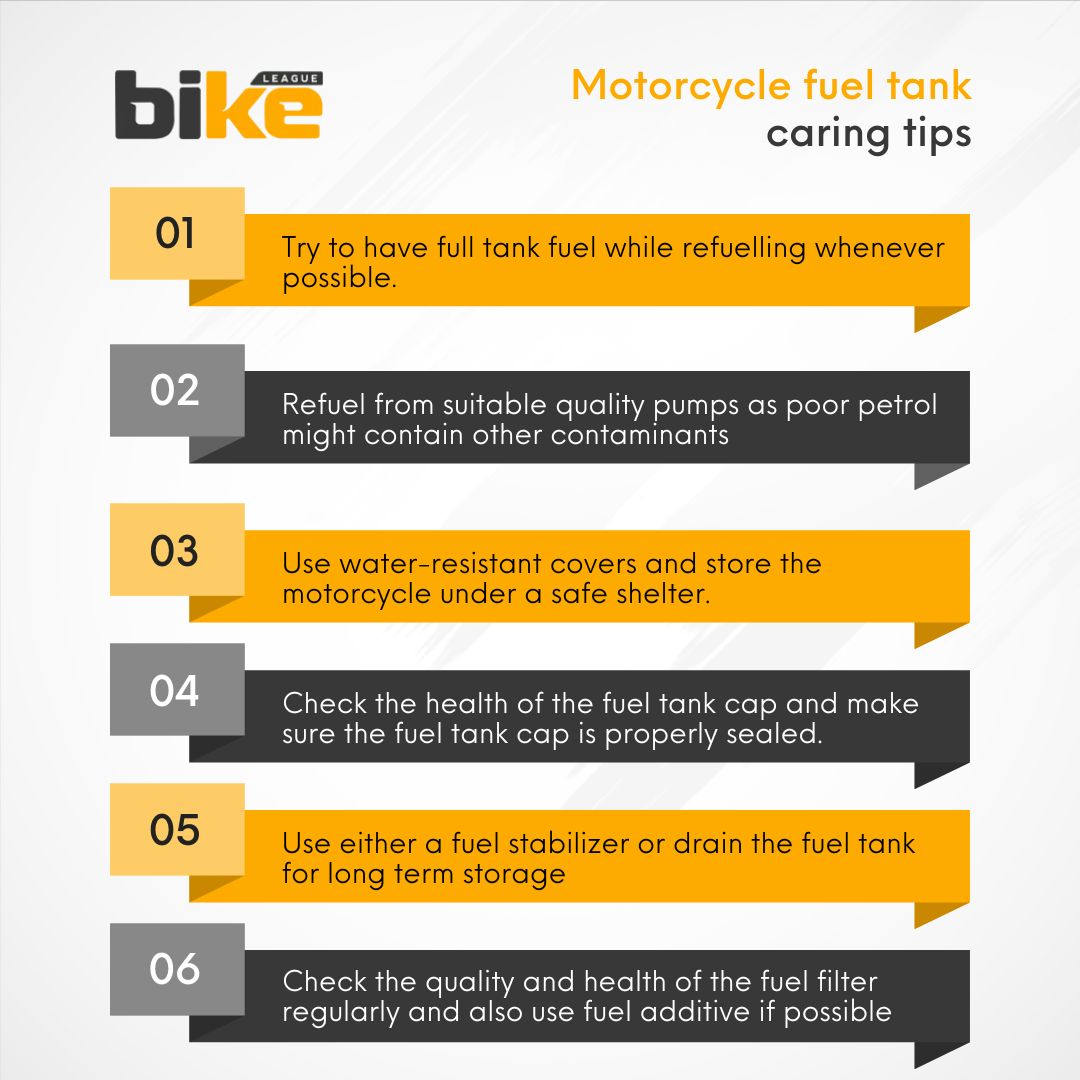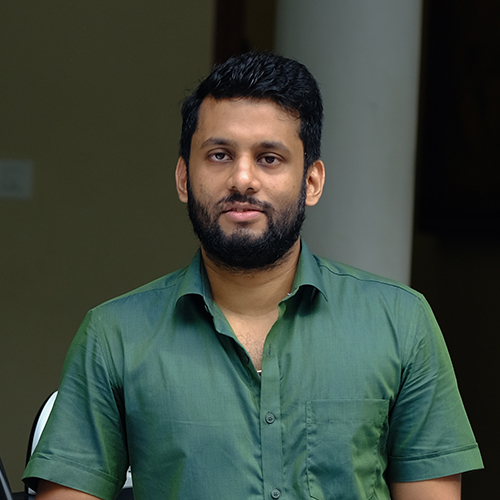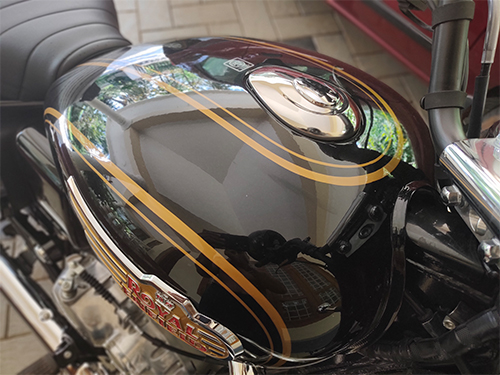
Long story short: In short, you can keep your motorcycle’s fuel tank in great shape by following these maintenance tips. Use the advice below to prevent rust, avoid leaks, and keep your gas tank working well.
The petrol tank is a crucial component of your motorcycle. Still, it can develop issues such as leaks and rust over time. As riders, we want to avoid these issues. This article shares simple ways to care for your tank, prevent and remove rust, and offers tips on fuel and fuel pumps.
Key Takeaways
- Try to have a full tank of fuel while refuelling, which helps reduce corrosion as most of the tank material is covered in fuel.
- Also, try to refuel from suitable quality pumps as poor petrol might contain other contaminants which affect the bike’s petrol tank, the carburettor, and the fuel injector.
- Adding about 40-50 ml of fuel system cleaner every 1,000 km helps prevent gum and deposit buildup caused by ethanol, especially on throttle bodies and fuel injectors.
- Ethanol can cause swelling or cracking in rubber fuel hoses, injector O-rings, and fuel pump seals. Have these checked during service and replaced if needed.
- Ethanol’s hygroscopic nature attracts moisture, which can cause phase separation and corrosion. Avoid leaving E20 fuel in the tank for extended periods, especially if the bike is not ridden regularly. If needed, use a fuel stabiliser to protect the fuel.
What are the common issues faced by motorcycle fuel tanks?
The main issues faced in motorcycle fuel tanks are
- Rust in the motorcycle tank
- Water in the motorcycle tank
- motorcycle tank leakage
For long-term motorcycle owners, rust and leaks are common worries. Let’s take a closer look at these problems and explore how to address them.
1. Rust in the motorcycle gas tank
Causes of rust in the motorcycle tank
Most motorcycle fuel tanks are made from galvanised steel, which has a zinc coating to slow down rust. However, over time, all steel can rust, primarily due to the presence of moisture, such as condensation. When water vapour inside the tank turns into liquid and gets trapped, it reacts with the iron in the steel, causing rust to form.
How to prevent rust in the motorcycle gas tank?
To prevent rust in the motorcycle tank,
- Try to have a full tank of fuel while refuelling, which helps reduce corrosion as most of the tank material is covered in fuel.
- Also, try to refuel from suitable quality pumps as poor petrol might contain other contaminants which affect the bike’s petrol tank, the carburettor, and the fuel injector.
- If you live in an area where it rains or is humid, use water-resistant covers for your motorcycle while keeping it outside.
How to clean rust inside a motorcycle gas tank?
Cleaning a motorcycle fuel tank usually needs some experience and is not always a do-it-yourself job. Ensure that you disconnect the petrol tank from other parts before starting to clean, to keep things safe.
- Inspect the tank using a flashlight and determine whether it can be cleaned. Replacement is the best option if the tank is highly rusty or damaged.
- Remove the tank by draining the fuel and unhooking all the gas lines and sensors. It would be helpful if you didn’t do all of this.
- Remove rust using an acid, like vinegar or a commercial gas tank cleaner, and an agitator, like nuts and bolts. Shake this around in the tank throughout the day or for a longer period, depending on the amount of rust.
- After shaking the solution inside the tank, pour it out and rinse the tank with a garden hose. Add about five gallons of hot water mixed with dish soap, shake it around, and empty it again. Dry the tank with a hairdryer or heat gun on a low setting. Then, coat the inside with kerosene or a commercial sealer to stop new rust from forming. You might also want to replace the fuel gasket. Once done, your tank is ready to go back on the bike.
2. Water in the motorcycle gas tank
Causes of water present in the motorcycle tank
Water can enter your motorcycle’s tank through condensation or leaks at the fuel pump. Even a small amount of water can cause trouble for your bike.
How to prevent water from entering the motorcycle tank?
- Check the bike’s petrol tank cap and make sure the fuel tank cap is properly sealed and tightened to prevent water from getting into the tank.
- Adding a fuel stabiliser can help prevent water from entering the fuel system. One thing to note is that it should be used if you have not used the motorcycle for more than 30 days. Fuel stabilisers work by absorbing any water that may be present in the fuel. A fuel stabiliser also helps eliminate the need to drain your motorcycle’s tank.
- Use covers and store the motorcycle under a safe shelter if not using.
How to clean water inside a motorcycle tank?
- Drain & refill is the ideal solution to drain the tank, clean it, and refuel it with good-quality fuel.
- Replacing the old fuel filter is another good option. A fuel filter serves as a barrier to prevent water from entering the vehicle’s engine through the fuel tank.
- Rubbing alcohol can remove water from the fuel tank, a chemical that can settle at the tank’s bottom and absorb the water.
- Adding fuel additives to the fuel tank will help dilute the fuel and water.
3. Motorcycle tank leakage
Causes of motorcycle tank leakage
A hole in your motorcycle’s tank can happen because of rust or normal wear and tear, which leads to fuel leaks. Sometimes, fuel leaks can also come from other parts, not just the tank.
How to prevent motorcycle tank leakage?
The tips for preventing rust in the motorcycle fuel tank also apply here. Please refer to them above.
How to seal a motorcycle tank leak?
The safest way to fix a leaking petrol tank is to replace it. If you want to try repairing the leak, consult a skilled technician and discuss your options to determine the best course of action. Keep in mind that repairs can be risky and may not always be effective or last.
How to maintain a motorcycle fuel tank when using E20 fuel?
To maintain a motorcycle fuel tank with E20 fuel (20% ethanol), follow these important practices:
Key Maintenance Tips for E20 Fuel in Motorcycles
- Use Fuel System Cleaner Regularly: Adding about 40-50 ml of fuel system cleaner every 1,000 km helps prevent gum and deposit buildup caused by ethanol, especially on throttle bodies and fuel injectors.
- Monitor Engine Performance: Watch for rough idles, engine hesitation, or hard hot starts, which could signal throttle body clogging or fuel filter issues requiring cleaning or replacement.
- Inspect and Maintain Rubber Components: Ethanol can cause swelling or cracking in rubber fuel hoses, injector O-rings, and fuel pump seals. Have these checked during service and replaced if needed.
- Avoid Long-term Fuel Storage: Ethanol’s hygroscopic nature attracts moisture, which can cause phase separation and corrosion. Avoid leaving E20 fuel in the tank for extended periods, especially if the bike is not ridden regularly. If needed, use a fuel stabiliser to protect the fuel.
- Keep the Fuel Tank Full: Keeping the tank topped up reduces the air and moisture inside, minimising corrosion risks.
- Check Compatibility: Ensure your motorcycle is compatible with E20 fuel by checking the owner’s manual or sticker on the fuel cap. Most BS6-compliant motorcycles and newer models than 2023 are compatible.
- Professional Servicing: Regularly visit authorised service centres for fuel system cleaning and inspections relevant to ethanol use.
- Oil Monitoring: Ethanol can dilute engine oil, so monitor oil levels and adhere to recommended oil change intervals to maintain proper lubrication.
Additional Precautions
- Avoid water entry during vehicle washing or rainy conditions by ensuring the fuel cap is tightly closed.
- Drain the fuel and disconnect the battery if the vehicle will be parked for over a month.
- Expect a small drop in fuel efficiency (about 1-6%) due to ethanol’s lower energy content.
- For older motorcycles not designed for E20, consider following extra safeguards, such as additives or possibly sticking to lower ethanol blends until upgrade or adaptation is possible.
By following these steps, you can reduce the negative effects of ethanol in E20 fuel and help keep your motorcycle’s fuel system, engine, and overall performance in good shape for longer.
What are the signs that a motorcycle’s fuel tank needs cleaning or replacement in India ?
Signs that a motorcycle fuel tank in India needs cleaning or replacement include:
- Presence of rust inside the tank, which may cause fuel contamination and clogging.
- Sludge or sediment buildup is visible during inspection or felt when fuel flow is irregular.
- Symptoms include engine sputtering, misfiring, reduced fuel efficiency, or difficulty starting the motorcycle.
- Unusual noises from the fuel pump or a clogged fuel filter require frequent replacement.
- Water contamination is indicated by rough idling, engine hesitation, white smoke from the exhaust, or a foul odour from the fuel.
- Difficulty in fuel flow control if the petrol cock (fuel valve) becomes clogged or rusty, causing sluggish engine performance or sudden stalls.
- Fuel leakage or inconsistent engine power due to corroded or damaged tank parts.
It’s essential to check your fuel tank regularly, especially in India’s humid weather, which can speed up rust and water problems. Inspect your tank every few months, and if you notice any issues, clean or replace it as necessary.
Using good-quality fuel, adding fuel stabilisers that prevent rust, and storing your bike properly can help your tank last longer and lower the risk of rust or water getting in. Keeping your fuel tank clean also helps your engine run smoothly, especially in India’s riding conditions.
How often should I check for rust or water in my motorcycle gas tank in India ?
Because of India’s climate, you should check your motorcycle’s gas tank for rust or water every 3 to 6 months. It’s a good idea to inspect the tank every 2 to 3 months, especially during the rainy season, to catch any issues early. Every season, open the tank for a closer look and clean it if necessary to prevent rust, sludge, or water from accumulating and damaging your engine.
If you haven’t used your motorcycle in a long time, check the fuel tank before riding again, as condensation can cause rust or water to accumulate. Also, check the fuel filter and petcock regularly to identify any issues early. Fuel stabilisers can help with water issues, but it’s still important to look inside the tank yourself.
This routine prevents costly repairs and helps maintain optimal engine health in Indian riding conditions.
Is there a specific type of fuel stabiliser that is more effective for preventing water contamination in motorcycle fuel tanks in India?
To prevent water contamination in motorcycle fuel tanks in India, the most effective fuel stabilisers are those that combine corrosion inhibitors with ethanol protection and water tolerance properties. These stabilisers help prevent rust caused by water, suspend small amounts of absorbed water in the fuel to avoid phase separation, and some advanced types even enable the combustion of trace water in the engine. Products such as K100-G and STA-BIL are popular examples recommended for humid climates like India’s.
When choosing a fuel stabiliser, look for these key features:
- A corrosion inhibitor to protect the metal inside the tank from rust.
- Ethanol fuel stabilising properties to prevent ethanol-related water absorption and phase separation.
- Water tolerance that prevents water from separating and settling.
- Compatibility with gasoline and motorcycles.
Notably, fuel stabilisers do not remove water already present, but they minimise its harmful effects and prevent future contamination. Combining stabiliser use with regular tank inspection and proper fuel storage enhances fuel system health in Indian conditions.
Choosing these advanced stabilisers will help effectively safeguard your motorcycle’s fuel tank against water-related damage.
What specific types of fuel stabilisers are recommended for use in a motorcycle in India, with links ?
Recommended fuel stabilisers for motorcycles in India that effectively prevent water contamination and protect against ethanol-related issues include:
- Putoline Fuel Stabiliser – An advanced fuel system protection product that prevents petrol oxidation, corrosion, and deposits during storage. It is suitable if the motorcycle remains unused for a month or longer – Product Link.
- K100-G Fuel Treatment – A premium bio-based treatment reputed for chemically bonding with water to eliminate it and prevent phase separation. It is highly effective for ethanol-blended fuels, such as E10 and E20, which are commonly used in India. It also cleans the fuel system and improves mileage – Product Link.
- STA-BIL Storage Fuel Stabiliser – Keeps fuel fresh for up to 24 months, prevents corrosion, and protects the fuel system from ethanol and non-ethanol fuels. It is well-suited for long-term motorcycle storage and humid climates, such as those in India – Product Link.
- PROCTANE-EVO Ethanol Stabiliser – An Indian market additive designed for E10 and E20 petrol blends, which prevents rust, improves throttle response, and boosts octane. Used widely by Indian riders for ethanol fuel protection – Product Link.
- H-D Ethanol Guard Fuel Stabiliser (Harley-Davidson India) – Protects fuel systems from ethanol damage and keeps fuel fresh for up to 12 months. Suitable for motorcycles exposed to ethanol-blended fuels – Product Link
Select a fuel stabiliser that protects against rust, ethanol, and water for optimal results in India. You can find these products online or at local bike shops. Using them, along with regular checks and cleaning, will help keep your fuel tank and engine in good shape.
What are the best practices for safely disconnecting and removing the fuel tank for cleaning in India?
Best practices for safely disconnecting and removing a motorcycle fuel tank for cleaning in India include:
- Work in a well-ventilated, fire-safe area: Fuel vapours are highly flammable, so perform all work outdoors or in a garage with plenty of airflow. Avoid open flames, sparks, and smoking in the vicinity.
- Gather necessary tools and safety gear: Use gloves, safety glasses, and a fire extinguisher nearby. You’ll need basic tools, such as screwdrivers, wrenches, pliers, and possibly fuel line clamps.
- Turn off the fuel supply: Close the fuel petcock to stop fuel flow. Drain the remaining fuel either by running the engine until it dies or by carefully siphoning it into a safe container designed for petrol storage.
- Disconnect battery negative terminal: To prevent electrical sparks, always disconnect the motorcycle battery’s negative terminal before working on fuel components.
- Disconnect fuel lines and hoses: Use pliers or clamps to carefully loosen fuel lines from the tank. Be prepared to catch any dripping fuel with rags or a drain pan.
- Remove fuel tank mounting bolts: Typically found on the tank’s underside or sides, remove these bolts with the proper wrench or socket. Support the tank as you remove the hardware to prevent it from dropping.
- Lift and remove the tank carefully: Gently lift the tank away from the frame, taking care to avoid scratching paint or damaging hoses and wiring.
- Clean the tank safely: Empty any remaining fuel properly. Use recommended fuel tank cleaning solutions or a mild soap and water solution to clean rust, sludge, and residues. Avoid harsh chemicals that can damage paint or tank coating.
- Dry and inspect: Thoroughly dry the tank inside and out. Inspect for rust or damage needing repair or sealing before reinstalling.
- Reinstall carefully: Reverse removal steps. Ensure all hoses and electrical connectors are securely reattached, and the battery terminal is reconnected last.
By taking these safety steps, you can properly maintain your motorcycle’s fuel system in India’s climate and reduce the risk of spills, fires, or other problems resulting from handling mistakes.
FAQ related to maintaining motorcycle fuel tank
1. Why is regular cleaning of the petrol tank important?
Regularly cleaning the petrol tank is essential for fuel efficiency and preventing engine issues. A dirty tank can lead to clogged fuel filters and injectors, causing the engine to work harder and burn more fuel.
2. What are the signs that my petrol tank needs cleaning?
Signs that indicate your petrol tank needs cleaning include a noticeable decrease in fuel efficiency, frequent refuelling, engine sputtering or misfiring, and unusual noises from the tank. Additionally, finding water, dirt, or other impurities in your fuel clearly indicates that the fuel needs to be cleaned.
3. How often should I clean my motorcycle’s fuel system?
The fuel system should be cleaned regularly, according to your motorcycle’s recommended maintenance schedule, which typically occurs every 5,000 to 10,000 miles. Consult your owner’s manual for precise guidance.
4. What type of fuel should I use for my motorcycle?
Always use high-quality fuel at a suitable octane level, as recommended for your motorcycle. Ethanol-free gasoline is preferable as it is easier on the fuel system and prevents severe engine issues.
5. What are fuel stabilisers, and when should I use them?
Fuel stabilisers are additives that prevent fuel degradation and clogging during extended storage periods. They slow the oxidation process and prevent gasoline from absorbing water and evaporating, which is particularly important in humid or rainy areas.
6. How can I clean rust out of my motorcycle’s petrol tank?
To remove rust from a petrol tank, you can use a fuel tank cleaner specifically designed for motorcycles. Alternatively, products like Sea Foam or vinegar can be effective. Commercial products like ‘Evaporust’ can be used for severe rust, followed by a tank sealant to prevent future rust.
7. Is it necessary to use a fuel injector cleaner for motorcycles with carburettors?
No, fuel injector cleaners are formulated for motorcycles with fuel injectors. If your bike uses a carburettor, prioritise carburettor cleaning and maintenance instead.
8. What preventive measures can I take to maintain my petrol tank?
Preventive measures include keeping your tank full to minimise corrosion, using water-resistant covers to protect against moisture, and regularly inspecting all fuel system components for signs of deterioration. To sustain optimal performance, promptly replace any damaged parts.
9. Should I seek professional maintenance for my motorcycle’s fuel system?
Beyond personal maintenance efforts, periodic professional servicing with a certified mechanic is advisable for comprehensive inspections and adjustments. This ensures flawless fuel system operation and addresses any potential issues that may not be visible during routine checks.
10. How should I handle old or stale fuel in my motorcycle?
If your motorcycle has been in storage for a few months, drain the fuel in the tank and add fresh gas, along with a fuel stabiliser. For shorter storage periods, adding a fuel stabiliser at the time of storage can still be beneficial. Products like Sea Foam can also remove varnish from the fuel tank.
Other related articles from Bikeleague India
- Second hand motorcycle: Things to know when buying It
- E20 fuel & older motorcycles in India: What riders must know
- Ethanol blended petrol for Indian bikers – E10 & E20 Fuel
- Bike wash – Different types, procedures, precautions, FAQ
- Motorcycle chain – how to clean, adjust & maintain
Conclusion
We’ve covered the main problems with motorcycle tanks, their causes, how to prevent them, and ways to keep your tank in good shape. If you have any questions, feel free to email us at bikeleague2017@gmail.com. We’re always happy to help. You can also reach out to us on Bikeleague India’s social media platforms.

